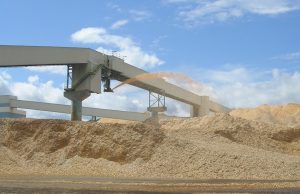Introduction
In North America, most woody biomass is transported by truck, whether it is logs, lumber, pulp chips, shavings, sawdust, wood pellets or wastewood / hog fuel. Trucks are versatile, plentiful, easily scheduled and economical over short distances. However, woody biomass is light and bulky and when transporting large volumes over long land distances, truck transport becomes costly; rail transport can be significantly less costly to use.
Transporting biomass by railcar has its challenges. Woody biomass takes many forms, shapes and sizes and can be a difficult-to-handle material, particularly getting it out of containers such as railcars.
Wood chip transport by railcar became popular in North America in the 60’s and 70’s with the determination that properly prepared sawmill residuals could be used for pulp chips. Several hundred specially designed wood chip railcars were constructed and most of these railcars are still in use today.
Pulp chips make up the bulk of woody biomass being transported by rail in North America. Pulp chips tend to be fairly uniform in size, but knit together after transport in box cars. And, the chip moisture content can vary significantly, which can be a problem in very cold climates. Wood chips will self-heat from biological action and oxidation if left to sit for awhile, and snow that might be sitting on top, melts and freezes at the bottom of the railcar.
Wood pellets are also transported by rail, more so as the world demand for pellets increases.
In BC, pulp chips and wood pellets are routinely transported hundreds of kilometers by rail from the BC interior to the ports in Vancouver and Prince Rupert for trans-loading onto ships. Continue reading →

 volumes of wood chips prior to the pulping process. Storage volumes of 120,000 BDt (750,000 m³) are not uncommon. The value of these chips is in the tens of millions of dollars, so mills have very specific requirements for storing wood chips to minimize fibre losses and maximize fibre recovery.
volumes of wood chips prior to the pulping process. Storage volumes of 120,000 BDt (750,000 m³) are not uncommon. The value of these chips is in the tens of millions of dollars, so mills have very specific requirements for storing wood chips to minimize fibre losses and maximize fibre recovery.